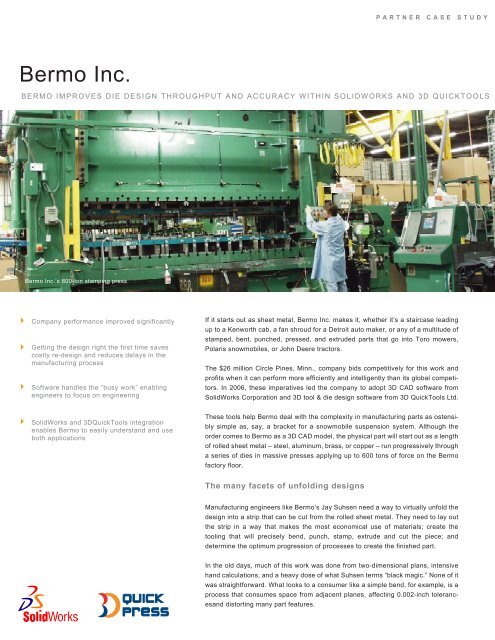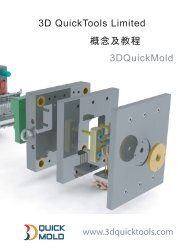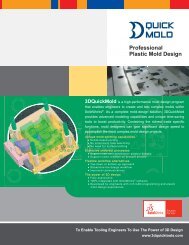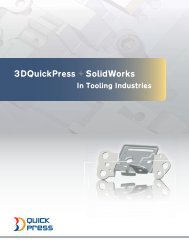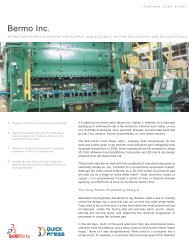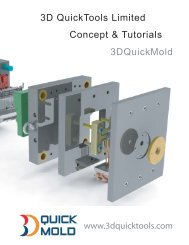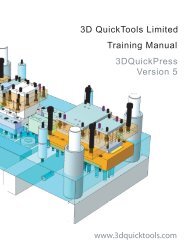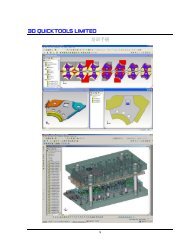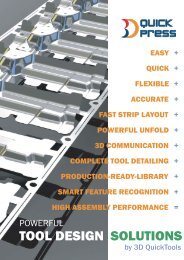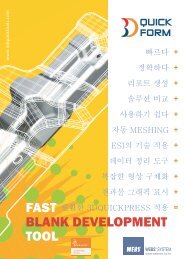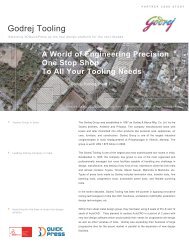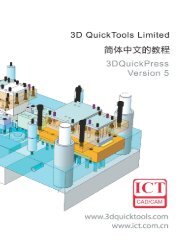English - 3D CAD/CAM Design Software
English - 3D CAD/CAM Design Software
English - 3D CAD/CAM Design Software
- No tags were found...
Create successful ePaper yourself
Turn your PDF publications into a flip-book with our unique Google optimized e-Paper software.
“ As designers, we’re able to do a largervolume of work and eliminate human error.As a company, we’re also making betteruse of our materials. The overall result is asignificant improvement in performance.”Jay Suhsen,manufacturing Eengineer, Bermo, Inc.“You can’t afford to stack up a lot of errors,” says Suhsen. “The flat blank needs to be veryprecise, and we don’t have time to develop multiple prototypes.”Getting the flat blank right used to take an hour and a half and the strip layout two to threehours for a typical straightforward part. It required a lot of checking afterwardand stillallowed human error. Since there is no time for prototypes, Bermo would start productionand check the first few parts. If they were okay, the press would keep running. If not, it wastime to redesign the part and hopefully cut losses.“Today, with SolidWorks ® and <strong>3D</strong>QuickPress ® software, the flat blank can take less thana minute, the strip layout under an hour, and there are no errors,” says Suhsen.“<strong>3D</strong>QuickPress takes a part model designed in SolidWorks and virtually unfolds it on thecomputer screen into the flat blank. It unfolds models that most <strong>CAD</strong> programs couldn’t.We don’t spend time checking and double-checking any more because we haven’t founda single case where <strong>3D</strong>QuickPress unfolding has been wrong. It’s just right the first time.”Economy mattersThe flat blank is only step one. The next step is virtually positioning multiple flat blanks onthe unrolled sheet so they make the best use of the expensive material.Bad decisions herecan cost thousands of dollars over a high-volume part run. Consequently, Bermo uses<strong>3D</strong>QuickPress’s optimize command to position the flat blank in the strip in the mosteconomical position possible, often automatically “nesting” parts – think of the yin yangsymbol – to minimize waste. This spares Suhsen and his colleagues time, tedium, trial,and error. “We’re trying to pinch every penny to beat competitors, and this is one effectiveway to do it,” he says. “<strong>3D</strong>QuickPress is always right.”Bermo Inc. die designFor small quantities, a run of 1,200 parts or fewer, Bermo sends unfolded part files to anyof five 4,000-watt lasers using SigmaNEST ® programming software. Because SolidWorksinteroperates seamlessly with SigmaNEST, Bermo no longer has to convert files to neutralformats, which can introduce stray files and, consequently, more chance for error.For high-volume runs of up to 100,000 or more parts, the first step after strip layout andoptimization is deciding the progression of stamping, pressing, piercing, punching, andcutting the strip will undergo. Most strips undergo eight to 12 separate processes fromblank sheet metal to finished part. <strong>3D</strong>QuickPress automates this decision-making, helpingmanufacturing engineers plan the progression from die station to die station, with eachaction preserved in subsequent stations in the <strong>3D</strong>QuickPress application. “If three holeswere punched in station 3, those holes will be present in station 12,” says Suhsen. “Youdon’t have to draw the holes over and over at each station. With <strong>3D</strong>QuickPress, I cansimply drag and drop functions to the station where I think it works best. This is where theexpertise of the engineer really matters, and <strong>3D</strong>QuickPress handles all the busy work.”At this stage, the engineer submits the strip and die progression to a rigorous teamwidedesign review. “The strip is the roadmap to success,” Suhsen says. “Put abunch of people in a room scrutinizing it, and you come out of that room with a lot ofgood ideas. It used to take all day to incorporate their recommendations. Now I justdrag and drop to incorporate their ideas.”
Wireframe lower die setFinally, the engineer creates the tooling and dies to execute the die progression, selectingfrom a vast production-ready library (PRL) in <strong>3D</strong>QuickPress populated at Bermo byDayton tools. “They’re not just dumb library parts,” says Suhsen. “<strong>3D</strong>QuickPress growsselected tools to the size of the sketch and places them in the correct z (vertical) axis.Tooling selection associates with the original strip design as well as its place in the dieprogression. Click on a hole, for example, and the software automatically defines thecorrect punch, dictating the right part number and length. When the punch and die designsare complete, the SolidWorks/<strong>3D</strong>QuickPress data flows to the CNC-driven machines thatcut tooling bases from two-inch-thick metal plates. These plates are then fitted withselected tools and precision-mounted on the press.”When Bermo is making a part with especially complex drawn surfaces, Suhsen’s teamuses another <strong>3D</strong> QuickTools application. <strong>3D</strong>QuickForm ® unfolds complex drawn surfacessuch as the snowmobile seatback mount Bermo recently made. <strong>3D</strong>QuickForm calculatescurves, performs finite element analysis on the part, and assists the designer in determiningthe necessary tooling. “It’s pretty amazing when egg-shaped holes on the screenbecome perfect circles after the part is formed,” Suhsen says.In addition to automating strip, tool and die development, <strong>3D</strong>QuickPress add specializeddesign capabilities to the SolidWorks environment, such as the ability to create a slot, setelectrical discharge machining (EDM) start holes, close gaps, and replace splines – allautomatically.“SolidWorks and <strong>3D</strong> QuickTools software have a symbiotic, seamless relationship,”according to Suhsen. “They have similar menus and feature managers, making it easy torun both at the same time and leverage existing knowledge from one application to theother. With <strong>3D</strong> models being so complex these days, we need <strong>3D</strong>QuickPress more thanever just to develop the strip. Before, if you couldn’t draw a product on paper, you couldn’tpropose the product, so there was a limit to the complexity of part designs we unfolded.With the third dimension and solid modeling, things have gotten far too complex for themanual unfolding of parts.” As complexity soars, so do the benefits of using the rightsoftware.“As designers, we’re able to do a larger volume of work and eliminate human error,” hesays. “As a company, we’re also making better use of our materials. The overall result isa significant improvement in performance. That said, we’re still in the infancy stage. Wedon’t think we’re as good as we’re going to get. We’re still learning what these tools cando for us.”Bermo relies on authorized SolidWorks reseller Symmetry Solutions Inc. and StrategicTechnology Solutions (STS) for ongoing software training, implementation, and support.For more information........SolidWorks Corporation: www.solidworks.comBermo Incorporated: www.bermo.com<strong>3D</strong> QuickTools Limited: www.3dquicktools.comStrategic Technology Solutions: www.callsts.comSymmetry Solutions: www.symsolutions.comSolidWorks Corporation300 Baker AavenueConcord, MAma 01742, USAPhone: 1 800 693 9000Outside the US: +1 978 371 5011Email: info@solidworks.comwww.solidworks.comBermo Inc.4501 Ball Rroad NEneCircle Ppines, MNmn 55014Phone: 1 763-786-7676www.bermo.comSolidWorks, COSMOSWorks, and eDrawings are registered trademarks and PphotoWorks is a trademark of SolidWorks Corporation.Auto<strong>CAD</strong> is a registered trademark of Autodesk, Inc., in the USA and/or other countries. All other company and product names aretrademarks or registered trademarks of their respective owners. ©2008 Dassault Systèmes.


